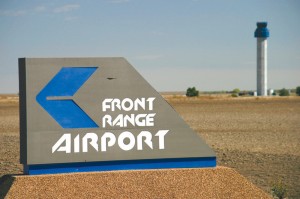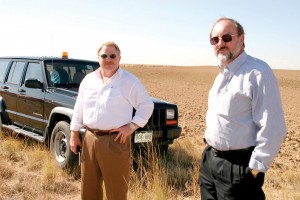By Jeff Mattoon

Dennis Heap, director of aviation at Front Range Airport, has great reason for an optimistic future.
Farmland for as far as you can see. Dirt everywhere. Why in the world would anyone be interested in this hunk of land? And why is there a new 200-foot, $6.2 million air traffic control tower on the site? Because on this one spot in Colorado there’s a harmonic convergence of aviation, rail and highway access that just might blossom into a model for intermodal transportation facilities nationwide.
Nicely nestled into a notch cut out beneath Denver International Airport’s Class B airspace, Front Range Airport (FTG) has emerged as a wonderful example of commerce and aviation coming together to create something greater than the sum of its parts. And if the pioneering fathers of this 20-year-old “little” airport have their way, Front Range Airport will emerge as an aviation powerhouse–and not just for Colorado, but for the whole world.
Are they talking about our little Front Range Airport? Driving to FTG, if you don’t know exactly where you’re going and if it weren’t for the road signs, you just might miss it. Cruising along two-lane roads north of I-70 and about 20 miles east of Denver, you pass through miles of seemingly barren farmland before noticing a strange and out-of-place spot on the horizon.
Jutting over farmhouses and between the occasional trees is a concrete stick with a blue geometrical “house” on top. It’s a brand new, state-of-the-art air traffic control tower owned by the airport and operated by the FAA–but for what? Certainly there can’t be enough traffic at this tiny airport. They may have two runways, but one of them is hardly ever used, right? Well, sort of. Before answering that question, let’s relive a little of the past.
A good old-fashioned showdown
Reminiscent of a classic western drama, a showdown began to brew in the 1970s and 1980s over the increasingly unpopular Stapleton International Airport. The old lady was landlocked and the runways were too close to each other for increased and safe foul weather approaches. Neighboring communities complained and sued, saying she was too loud.
The City and County of Denver, hat in hand, requested of Adams County expansion of the airport into its territory. Adams said no, but they did offer to cut a deal with the big city. In return for payments of lost property tax revenue, and the increased revenue from logical new surrounding developments, Adams County allowed Denver to annex a little over 35,000 acres to the north and east of the Stapleton location, out in the middle of nowhere, where no one would be bothered.
Part of the deal was that the new airport would handle passenger business; another offsite airport, to be built, would handle air cargo. As soon as they knew they had a deal, Adams County acquired the land, some 3,300 acres, and commissioned the creation of an airport of sufficient size to accommodate cargo aircraft.
In fact, the new airport property is two-thirds the size of the old Stapleton Airport and is large enough to fit both Jeffco and Centennial airports inside its boundaries. Initially, two 8,000-foot runways were built with enough room to expand to 10,000 feet each, as business developed. Things were looking golden for Adams County and the new cargo airport, now called Front Range.
About 10 years passed before the whole Stapleton/DIA transition came to fruition, but that was OK, because Adams County had a new airport that was destined to sprout into a serious revenue machine.
Three-card monte
That excitement, however, was extinguished when some alleged backroom dealings between the City and County of Denver and a large and powerful commercial airline company bro ught about the moving of all the cargo operations to DIA. Denver and the airline company were united in their effort to house FedEx, UPS and all other cargo operators at the new international airport instead of Front Range.
Ostensibly, the large airline was concerned that the little airport would one day grow to not just have the ability to accommodate competitive, low-cost airlines, but would aggressively solicit for such business. So, instead of waiting for the perceived inevitable, the big airline worked to stunt the new baby’s growth and insisted that a chunk of land on the south end of DIA be devoted to air cargo. At the time, the reason given for the change was based on the new airport needing all the revenue sources it could find due to spiraling construction costs.
For nearly a decade, the little airport on the prairie struggled for survival, attracting only a handful of aviation operations–nothing major. For many years, the scene around Front Range was reminiscent of a ghost town. Weeds sprouted in the middle of the little streets, and dust blew everywhere. For a while FTG appeared doomed to closure.
New sheriff in town
In 1994, Adams County hired Dennis Heap as the new director of aviation for Front Range Airport. He knew coming in that it wasn’t going to be an easy job.
“When I got here, I thought ‘What’s going on? This is a lot of facility for the small amount of activity.’ The most common question I was asked was, ‘When is this place going to shut down?'” said Heap.
It took Heap a little while to gather all the pieces of the puzzle that made up FTG. In 1997, a very pivotal meeting took place. All entities with a stake in Front Range Airport to one degree or another came together–some 60 people. Those represented included the FAA, DIA, UPS, the Colorado Department of Transportation Division of Aeronautics, the City of Aurora, Adams County, Arapahoe County, the National Business Aviation Association and the Aircraft Owners and Pilots Association.

At nearly 200 feet, the air traffic control tower at Front Range Airport is the tallest in North America.
“One thing we all agreed on in that meeting was that FTG shouldn’t be allowed to whither away. On the contrary, a new master plan should be drafted to reflect the three components necessary for growth of the airport. They were a direct road connection to DIA, which sits just six miles to the northwest; the construction of an air traffic control tower; and development of large hangar space,” remembers Heap.
One thing couldn’t be denied by all players: the land mass that was called Front Range Airport, which is about 3,300 acres, couldn’t be wasted. When you put the puzzle together, you have an impressive and valuable piece of property. A piece of property that has access to a major international airport, rail service and a major interstate highway on the southern boundary. And maybe most importantly, a piece of property that has no residential encroachment.
By design, FTG has one of the strongest airport influence zones in the state. An AIZ is the area where current or future airport-related noise, overflight, safety and/or airspace protection factors may significantly affect land uses. A strong AIZ means that commercial and residential developments cannot come close enough to inhibit airport growth. And to be sure, Front Range Airport is growing.
When he took the job, Heap was looking for a five-year steppingstone to a cushier job at an airport in the mountains, but the five-year plan has turned into a longer-lasting challenge. The vision Dennis Heap latched onto in 1997 was that Front Range Airport had the potential to not just become a simple cargo-serving airport, but an international multimodal commerce hub–and that’s what’s happening.
A game of dominoes, anyone?
It’s not exactly clear which domino fell first, or which one was the most influential, but those dominoes are sure beginning to fall at Front Range Airport. Ken Lawson, who’s been the assistant airport director for two and a half years now, believes the tower gets much of the credit.
“Interest in the tower is much stronger at this stage than I thought. I really believed it would take about a year of the tower being operational before the phone started ringing with any regularity, but that’s happening now,” says Lawson.
It seems as though business aviation has been eyeing Front Range for some time, but for insurance reasons, they couldn’t utilize the airport because it was uncontrolled. The tower was fully operational on August 1 of this year. Like a siren of the sea, it’s been calling businesses from all over the country and all over the state to Front Range.
In a major announcement heralding the boon in growth at FTG, Aviation Technology Group, with much fanfare and a visit from Congressman Bob Beauprez, presented its plan to keep the company’s production facilities in Colorado by locating them at Front Range.
“Our county commissioners are very supportive of companies that create quality, high-paying jobs, and this is one of the best companies I’ve ever worked with in that regard,” said Sandra Steiner, executive vice president of business development for Adams County Economic Development, adding that the defining moment was when all parties sat at the table and determined to keep ATG from moving out of state at all cost. “When you get that much cooperation on the local level all the way to the state, it doesn’t get much better than that.”
That announcement, along with the opening of the tower, has created a buzz that has Dennis Heap and all principal parties ecstatic.
One of the first major commitments to FTG came from the Emily Griffith Opportunity School, operated by the Denver Public Schools. EGOS is a post-secondary technical training school with its headquarters and main campus in Denver. One of the courses offered is the FAA approved Airframe Technician Program, which prepares students for employment in the general and commercial aviation industry. Students can attend school at Front Range and conveniently traverse the relatively new 56th Avenue connector road between FTG and DIA.
“The linchpin in the decision to move to Front Range was the opening of 56th Avenue between DIA and Front Range Airport, which has cut the travel time to less than 20 minutes,” offers Heap.
Whether you compare the FTG sequence of events to dominoes or to a puzzle, many of the pieces are coming together and each affects the other. The availability of qualified manpower from Emily Griffith was a contributing factor in ATG’s move to Front Range, according to Heap.
In 2004, Union Pacific Railroad quietly announced their intention to move their central rail freight yard from Denver to the Front Range location at a development spearheaded by the Colorado Springs-based Schuck Corporation. The project, known as TransPort, will provide the connection between trucking, rail and air cargo–all providing fuel for the Front Range revenue fire.
As things have a way of going full circle, the move of the central rail yard out of Denver has created quickened anticipation of new commercial and residential development at the current site in downtown Denver. Mayor John Hickenlooper has commented on the potential for greatly increased property values (read tax revenues) at the current rail yard location once the move is complete.
With an air traffic control tower operational, the 56th Avenue connector road to DIA complete and large hangar development occurring at Front Range, the three-point plan set out years ago is nearly fulfilled, beckoning the first commitment from an air cargo operation.
So in this western prairie tale, it seems that all parties are going to win. As the little-big Front Range Airport celebrates it twenty-first birthday, the locals will get availability of good high paying jobs, the county gets tax revenue and the state gets all of the above.
Congratulations, Front Range. You’ve earned it.
For more information, visit [http://www.ftg-airport.com].












